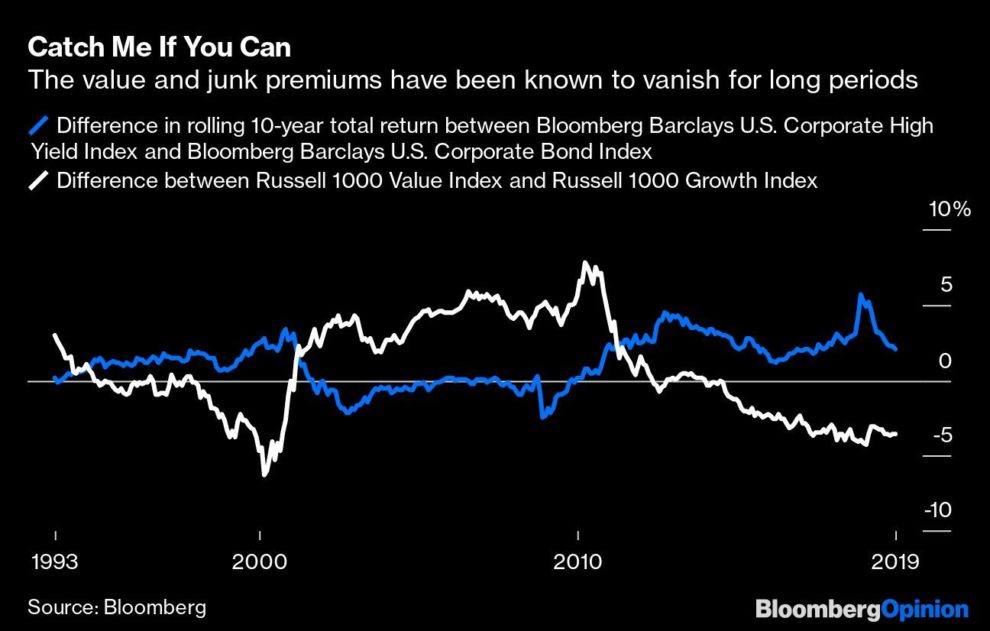
(Bloomberg Opinion) — If you want to know why U.S. investors are down on value stocks, just consider junk bonds.
Last year was another miserable one for value investing. The Russell 1000 Growth Index outpaced the Russell 1000 Value Index by 9.8 percentage points, including dividends. It couldn’t have come at a worse time because value investors were already reeling from a multiyear drought. Growth beat value in eight of 12 years from 2007 to 2018, more than doubling the return from value during the period.
By the summer of 2019, investors began wailing about the death of value investing even as their faith in junk bonds remained unshaken. It’s a striking contrast because value stocks and junk bonds are essentially the same investment in different parts of the capital structure. Bond investors buy junk because they expect to be better compensated for lending to troubled companies than they do for stable ones, as do stock investors when choosing beaten-down value companies over those with highflying growth. Both expectations are supported by decades of data. Junk bonds have historically paid a premium over investment-grade bonds, but with more volatility. The same has been true for value versus growth stocks.
If you doubt that value and junk are two sides of the same coin, consider that companies whose bonds are in the junk bin are also likely to find their shares on the discount rack. Of the roughly 1,200 companies in the Russell 3000 Index for which a long-term credit rating from S&P Global Ratings is available, the median price-to-book ratio of firms rated junk (BB or lower) is 17% lower than that of those rated investment grade. Other valuation measures tell a similar story. The median price-to-sales ratio of companies rated junk is 63% lower, price-to-earnings is 15% lower and price-to-cash flow is 35% lower.
Companies rated junk are also bigger targets for short-sellers, or investors betting that share prices will decline, another sign that trouble tends to spread across the capital structure. The median short-interest percentage of companies rated junk, or the number of shorted shares relative to outstanding ones, is three times greater than that of firms rated investment grade.
Which raises the question: If the value premium is dead, why should the junk premium persist?
You won’t find a satisfying answer in theories about value’s purported end. The two I hear most are that the popularity of value investing killed it, mostly because of the proliferation of value funds, and that value companies can’t compete with the innovation, technology and scale of growth firms — the classic new beats old, Amazon beats Walmart, Tesla beats Ford, Netflix beats Walt Disney and so on.
But if those theories have merit — and I’ve already expressed my doubts — then junk bonds should be no more appealing. For one, junk appears to be far more popular than value. Value has rarely been as cheap relative to growth as it is today, while junk has rarely been as expensive relative to investment-grade bonds. Also, buying junk is likely to land investors in many of the mature companies that dominate value, as the overlap between value and junk shows. If anything, investors ought to be more worried about junk than value.
So why has all the angst around value eluded junk? An obvious answer is recency bias: Bond investors have been rewarded for buying junk in recent years, whereas stock investors have been punished for buying value — and nothing makes investors more contemplative than underperformance or less curious than outperformance. While the Bloomberg Barclays U.S. Corporate High Yield Index outpaced the Bloomberg Barclays U.S. Corporate Bond Index by 1.6 percentage points a year from 2007 to 2019, value underperformed growth by 4.4 percentage points a year during the same period.
A more subtle answer is availability bias: The premium is harder to discern for value than for junk, so it’s easier to wave away. With junk bonds, it’s a simple matter of comparing yields. For example, the yield for the high-yield index is 5.6%, compared with 2.6% for the corporate bond index, or an expected premium of 3 percentage points.
For value stocks, the least amount of effort probably entails calculating a ratio of earnings to price, which would yield 3.3% for the Russell growth index, based on 12-month trailing earnings per share, and 5.6% for the value index, or an expected premium of 2.3 percentage points. A more detailed gauge would typically consider variables such as dividend yields, expected earnings growth and anticipated changes in valuation — far more sweat and guesswork than glancing at bond yields.
There’s no shortage of postmortems about value, but it’s not clear why value alone is marked for extinction. What is clear is that, like the junk premium, value has been known to vanish for long periods before reappearing. Investors who think it’s gone for good should wonder what else in their portfolio is on the chopping block.
To contact the author of this story: Nir Kaissar at [email protected]
To contact the editor responsible for this story: Daniel Niemi at [email protected]
This column does not necessarily reflect the opinion of Bloomberg LP and its owners.
Nir Kaissar is a Bloomberg Opinion columnist covering the markets. He is the founder of Unison Advisors, an asset management firm. He has worked as a lawyer at Sullivan & Cromwell and a consultant at Ernst & Young.
<p class="canvas-atom canvas-text Mb(1.0em) Mb(0)–sm Mt(0.8em)–sm" type="text" content="For more articles like this, please visit us at bloomberg.com/opinion” data-reactid=”64″>For more articles like this, please visit us at bloomberg.com/opinion
<p class="canvas-atom canvas-text Mb(1.0em) Mb(0)–sm Mt(0.8em)–sm" type="text" content="Subscribe now to stay ahead with the most trusted business news source.” data-reactid=”65″>Subscribe now to stay ahead with the most trusted business news source.
©2020 Bloomberg L.P.






